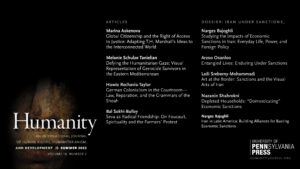Abstract: This paper asks, what might it mean to take seriously the claim that human rights processes are a form of ritual? It does so through an ethnographic analysis of the work of the UN Committee Against Torture. The apparent self-referentiality of human rights regimes has led some critics to argue that they have become an increasingly calcified process. This paper argues though that the formal ritual of the UN human rights monitoring process can create space for the moral imagination. More specifically, the rituals of human rights can create an “as if” of commitment to human rights, which takes shape despite, or even because of the problems and absences in existing practices.
Current Issue

Our long-awaited issue of Humanity journal is out! Its special dossier, Iran under Sanctions, examines the myriad and devastating impacts of international sanctions on society, culture, and politics. The issue includes an essay on the legal case Herero and Nama v. The Federal Republic of Germany to theorize reparations for German colonialism and slavery as they became linked with the aftermath of the Shoah. It also includes essays on T.H. Marshall and the right of access to justice; visual representations of Armenian genocide survivors; and, the concept of radical friendship in relation to the Farmers’ Protests in India.
View entire issue > Save Save Save
📘'Choose Your Bearing: Édouard Glissant, Human Rights and Decolonial Ethics' is now available for pre-order!
❕Grab your copy and save 30% OFF using the code NEW30 at checkout : https://edin.ac/3JIcRne
@HumanityJ